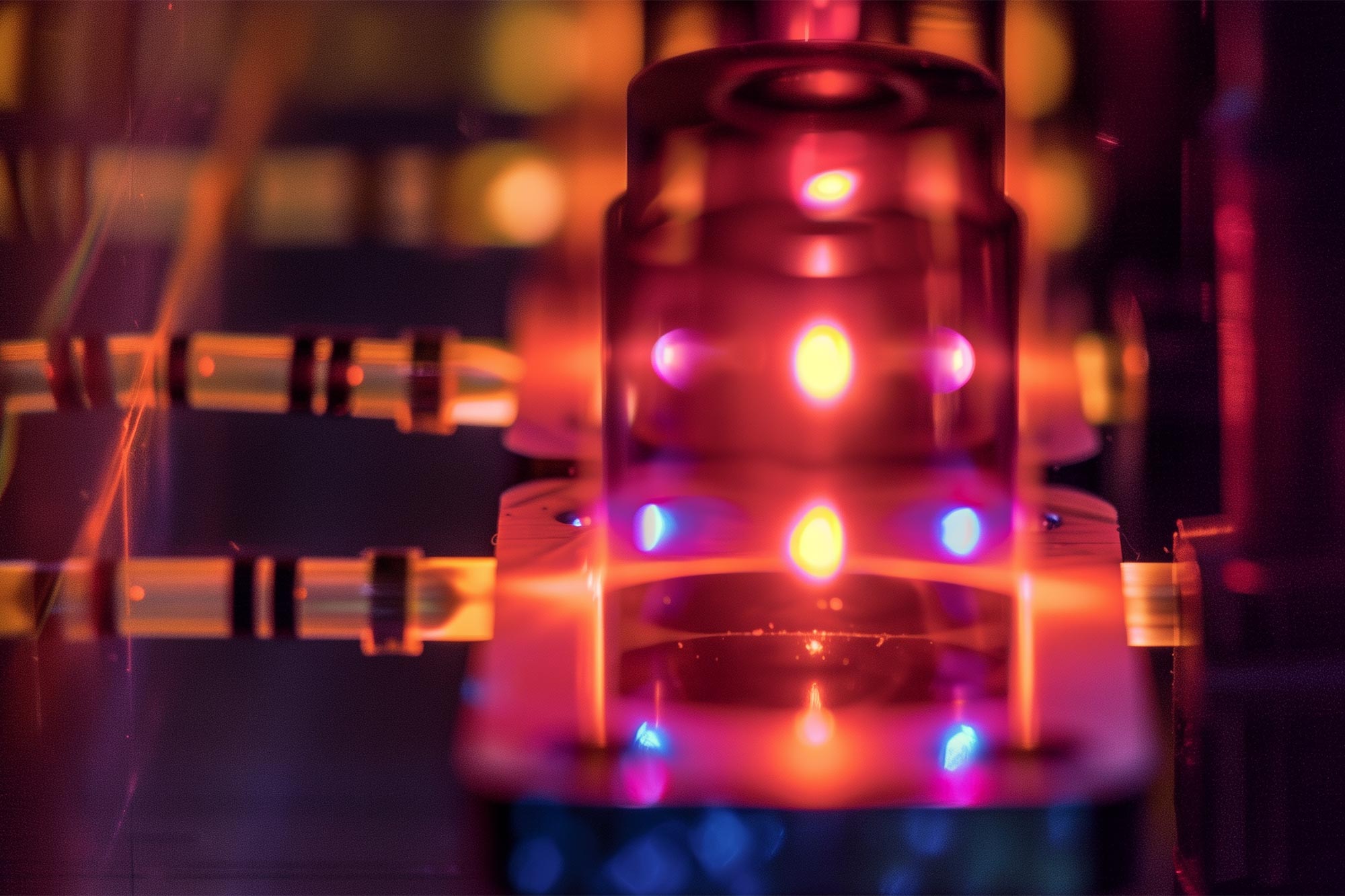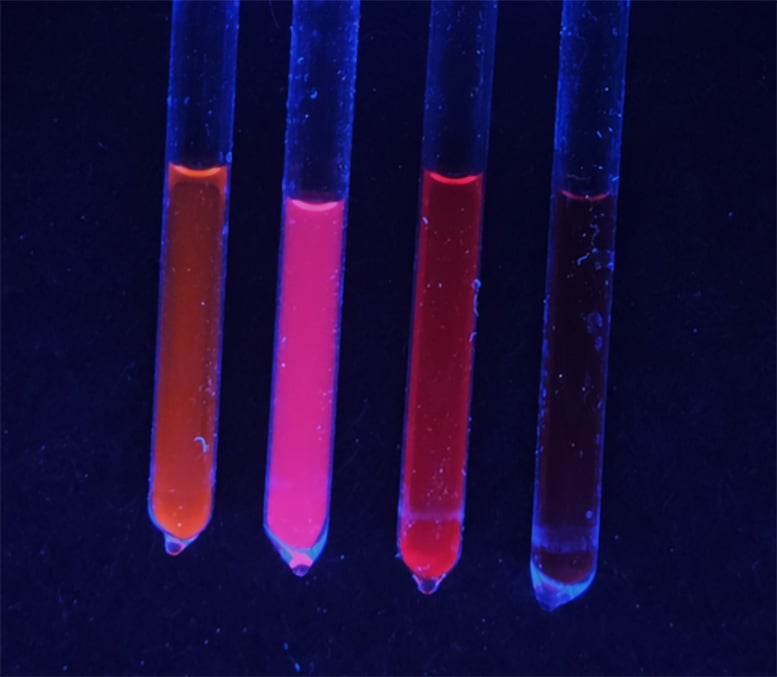量子突破使研究人员能够创造以前无法想象的纳米晶体
诸平

Fig. 1 A molten salt method has unlocked new materials for quantum dots, expanding their technological and scientific potential. (Artist’s concept.) Credit: SciTechDaily.com

Fig. 2 Colloidal solutions of gallium arsenide quantum dots of the type used in lasers, TVs, solar cells, medical devices, and other electronics glow under UV light. These were grown using a groundbreaking technique developed by UChicago’s Talapin Lab, a technique that opens a new world of materials for researchers growing nanocrystals. Credit: Courtesy of the University of Chicago/Talapin Lab
据美国芝加哥大学(University of Chicago, Chicago, IL, USA)2024年11月27日提供的消息,量子突破使研究人员能够创造以前无法想象的纳米晶体(Quantum Breakthrough Allows Researchers To Create “Previously Unimaginable Nanocrystals”)。
用熔盐代替有机溶剂使研究人员能够创造出“以前难以想象的纳米晶体”(“previously unimaginable nanocrystals”)。
被称为量子点(quantum dots)的半导体纳米晶体类型不仅扩展了纯科学的前沿,而且在实际应用中发挥着至关重要的作用,包括激光,量子QLED电视(quantum QLED televisions)和显示器,太阳能电池,医疗设备和其他电子产品。
最近发表在《科学》(Science)杂志上的一项培养这些微观晶体的新技术,不仅发现了一种新的、更有效的方法来构建有用的量子点,而且还为未来的研究人员探索开辟了一组新的化学材料。原文详见:Justin C. Ondry, Zirui Zhou, Kailai Lin, Aritrajit Gupta, Jun Hyuk Chang, Haoqi Wu, Ahhyun Jeong, Benjamin F. Hammel, Di Wang, H. Christopher Fry, Sadegh Yazdi, Gordana Dukovic, Richard D. Schaller, Eran Rabani, Dmitri V. Talapin. Reductive pathways in molten inorganic salts enable colloidal synthesis of III-V semiconductor nanocrystals. Science, 2024, 386(6720): 401-407. DOI: 10.1126/science.ado7088. Epub: 24 October 2024.
参与此项研究的除了来自美国芝加哥大学的研究人员之外,还有来自美国加州大学伯克利分校(University of California, Berkeley, CA, USA)、美国劳伦斯·伯克利国家实验室(Lawrence Berkeley National Laboratory, Berkeley, CA, USA)、美国科罗拉多大学博尔德分校(University of Colorado, Boulder, CO, USA)、美国阿贡国家实验室(Argonne National Laboratory, Argonne, IL, USA)、美国西北大学(Northwestern University, Evanston, IL, USA)以及以色列特拉维夫大学(Tel Aviv University, Tel Aviv, Israel)的研究人员。
“我很高兴看到全球的研究人员如何利用这项技术来制备以前难以想象的纳米晶体,”上述论文的第一作者、芝加哥大学德米特里·塔拉平实验室(UChicago’s Talapin Lab)的前博士后研究员贾斯廷·昂德里(Justin Ondry)说。
来自美国和以色列的研究人员组成的研究小组,他们用熔盐取代了通常用于制造纳米晶体的有机溶剂,即洒在烤土豆上的过热氯化钠。
“在你的脑海里,氯化钠不是液体,但假设你把它加热到如此高的温度,它就会变成液体。它和水有相似的粘度,是无色的。唯一的问题是没有人认为这些液体是胶体合成(colloidal synthesis)的介质,”芝加哥大学普利兹克分子工程学院和化学系{UChicago Pritzker School of Molecular Engineering (UChicago PME) and the Chemistry Department}的德米特里·塔拉平教授说。
何为用盐?(Why salt?)
量子点是最著名的纳米晶体之一,不仅因为其广泛的商业用途,而且因为最近发现量子点的团队获得了2023年诺贝尔化学奖(2023 Nobel Prize in Chemistry)。
上述论文的共同作者之一、美国加州大学伯克利分校(UC Berkeley)教授埃兰•拉巴尼(Eran Rabani)表示:“如果说纳米世界中有一种材料在应用方面对社会产生了影响,那就是量子点。”
然而,埃兰•拉巴尼说,之前关于量子点的许多研究,包括诺贝尔奖的工作,都是围绕着使用元素周期表中第二和第六族元素的组合来培养量子点的。这些被称为II-VI(2 – 6)材料{“II-VI” (two-six) materials}。更有前途的量子点材料可以在元素周期表的其它地方找到。
在元素周期表的第三和第五组(III-V材料)中发现的材料用于最高效的太阳能电池,最亮的LED,最强大的半导体激光器和最快的电子设备。它们有可能制造出很棒的量子点,但除了少数例外,它们不可能在溶液中生长纳米晶体。制造这些材料所需的温度对于任何已知的有机溶剂来说都太高了。熔盐可以满足高温需求,使这些以前无法获得的材料变得容易获得。
“德米特里·塔拉平教授的团队首次在熔盐合成方面取得了独特的进步,开创了许多以前根本无法获得胶体合成的材料,”受美国阿贡国家实验室和美国西北大学的联合聘用的上述论文共同作者理查德·沙勒(Richard D. Schaller)说。“许多这些新材料现在可以在基础和应用上取得进展,同时,现在有一个全新的合成前沿可供学术界使用。”
量子时代(The Quantum Age)
上述论文的第二作者、芝加哥大学研究生周梓睿(Zirui Zhou音译)说,研究人员在合成纳米晶体时忽略熔盐的原因之一是它的强极性。
盐中带正电的离子和带负电的离子相互之间有很强的吸引力。像纳米晶体这样的小东西的表面电荷很小,所以研究人员认为,当盐离子进入时,电荷会太弱而无法推回。任何生长中的晶体在形成稳定的物质之前都会被粉碎。至少之前的研究人员是这么认为的。
周梓睿说:“这是一个令人惊讶的发现。这与科学家传统上对这些系统的看法非常矛盾。”
这项新技术可能意味着更好、更快的量子计算机和经典计算机的新基石,但对研究团队的许多人来说,真正令人兴奋的部分是开辟了新的研究材料。
贾斯廷·昂德里说:“人类历史上的许多时代都是由人类拥有的材料来定义的,比如青铜时代或铁器时代。在这项工作中,我们已经解锁了合成近12种新的纳米晶体成分的能力,这将使未来的技术成为可能。”
上述介绍,仅供参考。欲了解更多信息,敬请注意浏览原文或者相关报道。
UChicago researchers unlock a ‘new synthetic frontier’ for quantum dots
Researchers Unlock New Frontier for Quantum Dots with Molten Salt
Editor’s summary
Members of the III-V semiconductor family, ranging from binary species such as gallium phosphide (GaP) and gallium arsenide (GaAs) up to pentanary compositions, can now be grown as monodisperse nanoparticles in eutectic melts of inorganic salts. Ondry et al. found that a wider range of semiconductors could be made if, instead of Ga(III), a weaker oxidizing species, Ga[GaI4], was used in the redox reactions. This approach allowed higher reaction temperatures that enabled synthesis of GaAs nanoparticles that showed band-edge photoluminescence. —Phil Szuromi
Abstract
Colloidal quantum dots, with their size-tunable optoelectronic properties and scalable synthesis, enable applications in which inexpensive high-performance semiconductors are needed. Synthesis science breakthroughs have been key to the realization of quantum dot technologies, but important group III–group V semiconductors, including colloidal gallium arsenide (GaAs), still cannot be synthesized with existing approaches. The high-temperature molten salt colloidal synthesis introduced in this work enables the preparation of previously intractable colloidal materials. We directly nucleated and grew colloidal quantum dots in molten inorganic salts by harnessing molten salt redox chemistry and using surfactant additives for nanocrystal shape control. Synthesis temperatures above 425 ℃ are critical for realizing photoluminescent GaAs quantum dots, which emphasizes the importance of high temperatures enabled by molten salt solvents. We generalize the methodology and demonstrate nearly a dozen III-V solid-solution nanocrystal compositions that have not been previously reported.